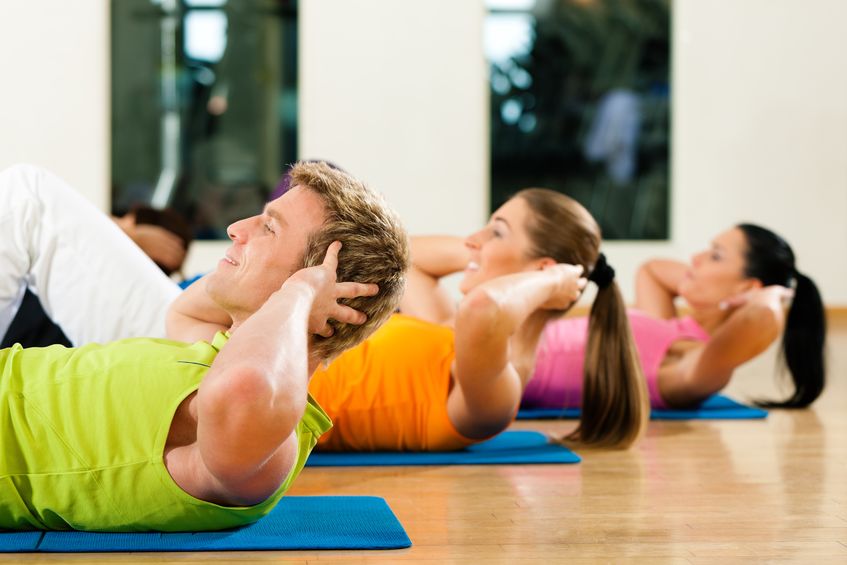Exposing 10 Common Exercise Myths

Myths About Exercise That May Hinder Your Workouts
Believing a variety of exercise myths can lead to poor workout habits, lack of physical activity or even injury. As a result, many of us fail to realize the full benefits of exercise in our daily lives. Regular workouts help reduce stress, improve wellness and can even be a source rich social interaction. By exposing these ten myths about exercise, we hope to encourage a healthy lifestyle and a willingness to engage in some exercises that you may have avoided due to incorrect understanding.
Myth 1: Abdominal exercises will flatten your stomach
The abdominal wall is made up of several groups of muscles. Excessive adipose tissue (fat) will cover the muscles, making the abdomen “stick out.” Abdominal exercises strengthen the underlying muscle structure, but will not “burn off” the fat. To reduce the fat tissue, you must reduce the caloric intake and perform cardio vascular exercises.
Myth 2: Pilates and other exercises can create long lean muscles
There are no exercises that can change the length of a muscle. Muscle in general is lean tissue, and the length is determined by genetics. Three body types exist: endomorph, mesomorph and ectomorph. The only type of body type that will have “long, lean” muscular appearance is the ectomorph.
Myth 3: Rest is best when you are sore from exercise
By reducing soreness, you’ll actually feel more relaxed. Soreness or exercise-induced pain is often a result of swelling of the muscle cells known as Delayed Onset Muscle Soreness (DOMS). DOMS swelling increases the fluid volume within the cells. This causes greater pressure within the cells and distention of the cell’s membranes, leading to muscle pain. Low level exercises (similar to the exercises that caused the pain in the first place) will enhance blood flow to the individual muscle cells and help to reduce the pressure and fluid volume within the cells. This will decrease the pain to the touch and pain when the muscles are used or stretched.
Myth 4: Lactic acid “build-up” causes muscle pain after exercise
As mentioned above, the pain following exercise is usually associated with DOMS. Lactic concentrations increase drastically when the muscles are worked in an anaerobic state (without oxygen) but it reduces quickly after activity subsides. Power/explosive motions such as plyometrics, sprints, high intensity lifting, etc. can cause a burning sensation to be felt in a muscle. This burning is a “build-up” of Lactic acid within the muscle cells. This “build-up” creates an environment that is too acidic for the muscle to continue to function, and the ability of the muscle to generate force is lost. Studies have shown that approximately 75% of the “build-up” will disperse via normal blood flow associated with exercises within 1-2 minutes of stopping the activity. There is very little “build-up” the next day.
Myth 5: Fat turns into muscle with exercise or vice versa
Fat and muscle are two separate and different cell types. One cannot become the other regardless of exercise intensity. Muscle tissue is lean. If muscle is not used or does not have a neural innervation, the fat cells can infiltrate the muscle cells and give a “marbling” appearance. This greatly affects the muscle’s ability to generate force.
Myth 6: If I am a woman and I lift heavy weights, I will get big and bulky
The vast majority of woman (all most all of them!) cannot develop big, bulky muscles without utilizing artificial means (steroids, HGH or testosterone). Women do not have a high enough level of testosterone in their systems to “build” large muscle mass. Testosterone levels in most men enables them to develop muscle mass via the “over-load” principle. If enough weight is lifted enough times, the muscle cells are damaged and then heal bigger and stronger. Unfortunately or fortunately depending on your personal views, women do not have the same capability.
Myth 7: If I sweat a lot I must be working hard
Sweating is the body’s way to cool down. If the exertion level is intense and the temperature is high, you are going to sweat. The amount of “exertion” that the body experiences does not have to be intense to be excessive and good. You can “burn” calories and improve your health with low intensity cardiovascular exercises such as long walks, but you probably won’t sweat a great deal while doing it.
Myth 8: Caffeine drinks prior to exercise will dehydrate you
Most people can drink almost anything and continue to workout without the fear of dehydrating themselves. Caffeine does cause someone to urinate more frequently, but it has not been shown to be significant. Sugary drinks make the absorption of water from the GI tract more difficult to achieve, therefore these should be avoided before exercising, if possible.
Myth 9: If I don’t hurt when I exercise, I am not achieving anything
Pain is the body’s way of telling us something is wrong. Unchecked this could possibly cause damage. Not all pain is bad! Muscle tissue pain may be experienced after heavy exertion and use. This pain is natural and needed if the muscle is to be developed (i.e. weight lifting). Muscle pain may worsen within the first two days of a “heavy” workout, but will dissipate within a couple of days. This type of pain improves with less intense exercise.
Joint pain is different. If the pain is felt in the joint or near the joint, it is probably a precursor to damage. One should stop the exercise and assess the cause for their “joint” pain. In most cases, they have either attempted to lift something that is too heavy or their form is no good. Poor form during exercises can cause significant damage to various structures and lead to an injury that limits function for a long time or permanently.
Myth 10: Stretching reduces injuries
This has never been proven. In some cases, stretching might cause the athletes to produce less “power” and possibly lead to an injury or decreased performance at their event. The theory behind stretching and decreased incidence of injury is related to the assumption that someone who is more flexible will experience fewer injuries. There are people who are too flexible and often times the overall strength of the individual can better determine his or her propensity for injury.
The best type of stretching to perform is Dynamic stretching before an event. All types of stretching should be performed after the person has done a “warm-up” for several minutes. Any activity that gets the heart rate and body temperature elevated can be considered a warm up. Post-activity stretching can increase flexibility the most and should be performed daily if this is the desired result of an exercise routine. The most successful approach to reducing injuries is to combine a good stretching and strengthening program, and perform it several times per day.



























Trackbacks/Pingbacks